
Antilles Ketch
I should play the lottery more, because this has been a lucky summer. A few weeks back, work took me to the San Juan Islands, one of the most beautiful cruising grounds in the Pacific Northwest (don’t you love it when work does that?). And this week—in fact right now, as I type—I am looking out at sunrise over Martha’s Vineyard Sound. That’s two slices of sailing paradise in one month, the sort of island hopping that a sailor could get hooked on.
Martha’s Vineyard, or more broadly Buzzard’s Bay, along with Martha’s Vineyard and Nantucket, will always hold a special place in my seagoing heart. I learned to sail on these waters, spending at least a few weeks each summer with my Grandfather aboard his 46-foot, centerboard ketch called Antilles. _Antilles_ was a Sparkman & Stephens design, built from wood in 1958. To a small boy, she might has well have been the Starship Enterprise. She was beautiful, fast, a great seaboat, and designed to go anywhere. I sailed on her in many far-flung waters, but it is Buzzard’s Bay that brings up the most powerful memories. I can’t get on the ferry at Wood’s Hole, drive past New Bedford or Marion, or hear a story about Martha’s Vineyard without instantly seeing in my head a movie reel of powerful and warm memories.
For anyone who has never sailed Buzzard’s Bay and “the Islands”, it runs north and east of Newport and Narragansett Bay, and is bound by the Elizabeth Islands to the east. Pass through the swirling, fast-ripping currents between Wood’s Hole and Naushon Island, and you are into the Sound, with Martha’s Vineyard and then Nantucket on your bow. It is a world-class cruising ground, with a wealth of harbors and gunkholes to choose from, fine temperatures day and night, and a reliable sea breeze which pipes up to 15-20 from the southwest. There is probably no better place to learn the art of spending a few weeks aboard a well-found yacht.
My Grandfather also learned to sail in these waters, as a teen racing S-boats out of Padanaram with his buddy Waldo Howland (who went on to run the Concordia yard and introduce American cruisers to the Concordia yawl, perhaps the most beautiful cruising yacht ever mass-produced). Waldo would often join my grandfather and me and whatever cousins he had drafted as crew for the summer cruising adventure. The two old guys would engage in endless banter, overlaid with groan-worthy puns, while teaching the young ‘uns everything they knew about sailing and the secrets of Buzzard’s Bay. They’d be up early, and fire up the alcohol stove—the sickly sweet smell serving as my alarm clock–to start heating water for tea and soft-boiled eggs (my Grandfather spurned the convenience of propane when it became popular because he viewed any fuel that could blow up his sailboat as unseamanlike; never mind the raging, cabintop-scorching flames that resulted from the burner-priming procedure).
Hadley’s Harbor
With breakfast in progress, the two wise men would engage in a papal consultation on where we would be heading next, announce the result, and charge their initiates with laying out the course and headings on the chart. Whoever came up with the best result was awarded (and I swear this was a big deal)…. a quarter. Even now I can recall the delicious suspense of my Grandfather and Waldo poring over our earnest chart scribblings with mock-solemn attention, before announcing the day’s winner.
And thus we passed the summer days, snugged down during bad weather in Hadley’s Harbor, tucked into the perfectly protected anchorage at Cuttyhunk, making the fast passage through Wood’s Hole on a fair current (under sail, of course), so we could head over to Edgartown. I remember cool, foggy mornings before the sun burned the seascape clear and called up the seabreeze, driving to weather with the rail awash, watching Ted Kennedy sail by (accompanied by wry commentaries from Waldo and my Grandfather regarding his sail trim), learning to put a good “harbor furl” into the mainsail, and being instructed in proper oar-feathering technique while rowing the Dyer dinghy (called “Lesser Antilles”; did I mention the punning tradition?).
Buzzard’s Bay
That’s the way sailing traditions should be learned, passed down with humor and exacting care from generation to generation. Add in the beauty and majesty of a chain of islands, pretty harbor towns and hidden anchorages, a stiff breeze, and the vast Atlantic beyond, and it is the perfect cruising education. Today the Elizabeth Islands and Buzzard’s Bay—like everything else–are more built up, and anchorages like Cuttyhunk can get so crowded that you feel like you are parking at the mall. But nothing can erase happy memories that are burned so deep, and Buzzard’s Bay will always be a sailing ground that connects me to my youth and my family. It’s soul-stirring, and I will be back soon, on my own boat, with my children, to start the cycle anew.









